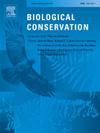Continental declines in North American small mammal populations
IF 4.9
1区 环境科学与生态学
Q1 BIODIVERSITY CONSERVATION
引用次数: 0
Abstract
We initially speculated that non-tropical North American (USA and Canada) small mammal abundances might have increased over the past several decades due to declines in mammalian predators. To test this idea we assembled from small mammal researchers 818 time series of small mammal abundances, containing a total of 5317 individual abundance data points, for 66 species in 21 genera. The resulting database is the largest collection of multi-year abundance data for North American small mammals. We then used a hierarchical Bayesian modelling approach to estimate an overall abundance trend. Contrary to our initial speculation, we found strong support for an overall decline in North American small mammal abundance, with an estimated annual decrease of 3.6 %. Sixty species trends were negative while only six were positive. Given this decline and given that small mammals are important for ecosystem function as prey items, as predators, and for seed dispersal, we suggest conservation efforts should be directed to this generally neglected group. In particular, we need further work to uncover the causes and consequences of small mammal declines, and to develop mitigation strategies to avoid further declines in North American small mammals.
北美大陆小型哺乳动物种群数量下降
我们最初推测,非热带北美(美国和加拿大)的小型哺乳动物的丰度可能在过去几十年里由于哺乳动物捕食者的减少而增加。为了验证这一观点,我们收集了来自小型哺乳动物研究人员的818个小型哺乳动物丰度时间序列,包含21属66个物种的5317个个体丰度数据点。由此产生的数据库是北美小型哺乳动物多年丰度数据的最大收集。然后,我们使用分层贝叶斯建模方法来估计总体丰度趋势。与我们最初的推测相反,我们发现北美小型哺乳动物数量总体下降的有力证据,估计每年减少3.6%。60种呈负向趋势,只有6种呈正向趋势。考虑到这种下降,考虑到小型哺乳动物作为猎物、捕食者和种子传播者对生态系统功能的重要作用,我们建议保护工作应该针对这个通常被忽视的群体。特别是,我们需要进一步开展工作,揭示小型哺乳动物数量减少的原因和后果,并制定缓解战略,以避免北美小型哺乳动物数量进一步减少。
本文章由计算机程序翻译,如有差异,请以英文原文为准。
求助全文
约1分钟内获得全文
求助全文
来源期刊

Biological Conservation
环境科学-环境科学
CiteScore
10.20
自引率
3.40%
发文量
295
审稿时长
61 days
期刊介绍:
Biological Conservation is an international leading journal in the discipline of conservation biology. The journal publishes articles spanning a diverse range of fields that contribute to the biological, sociological, and economic dimensions of conservation and natural resource management. The primary aim of Biological Conservation is the publication of high-quality papers that advance the science and practice of conservation, or which demonstrate the application of conservation principles for natural resource management and policy. Therefore it will be of interest to a broad international readership.
 求助内容:
求助内容: 应助结果提醒方式:
应助结果提醒方式:


